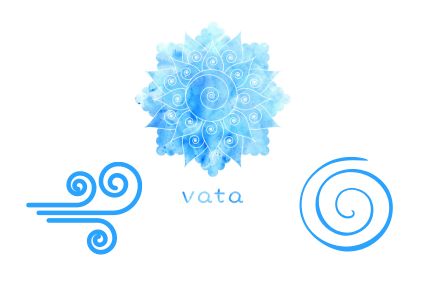The Vata Dosha

If we take the Vata dosha, which according to Ayurveda combines air and space, with a predominance of air, anything influenced by this dosha has airy qualities, i.e. it is mobile, light, cold, clear, subtle, dry, dispersive, erratic, astringent and rough. This will translate in a Vata type person into creativity, enthusiasm, freedom, generosity and a lot of imagination.
However, air is the wind, one idea chases the other, it lacks stability. Moreover, memory is not always very good under the influence of Vata. On the physical level, Vata's mobility makes it involved in all movements, large or small: stimulation of the nerves, sensory stimuli, creation of impulses and reflexes, inspiration and expiration, heartbeat, blood circulation, stimulation of digestive juices, ejaculation, exit of the fetus. As far as emotions are concerned, Vata maintains consciousness through the life force (Prana), stimulates tears and all expressions that express emotions.
Locations of Vata
Each dosha is associated with certain parts of the body, where its strength tends to be predominant. The doshas have a seat which is located in the gastrointestinal tract. The main function of the seat is to regulate the small daily changes of the dosha without disturbing the functioning of the body. Vata corresponds to the hollow organs, its seat is in the colon and its secondary locations are the thighs, the hips, the ear canals, the bones, the pelvic cavity and the nervous system. In the field of the senses, it is linked to the skin and therefore to the sense of touch.
The five forms or sub-doshas of Vata (air)

These forms or sub-doshas of Vata have names that consist of suffixes to which the root "an" is added, meaning to breathe or stimulate. The five forms or sub-doshas of Vata are: Prana, Udana, Vyana, Samana and Apana.
Prana means the fundamental air or nervous force. It corresponds to the brain rhythm. It diffuses into the head and is centered in the brain, moving down into the throat and chest. It governs inspiration, the rapidity of the rhythm of thoughts and concentration. It governs swallowing, sneezing, spitting and belching. It governs the senses, the mind, the heart and the consciousness. It is part of our cosmic life energy. It is our inspiration and connects us to our inner self. An imbalance in Prana can result in a dry mouth, sinuses or throat. It can also lead to a rhythm of thought that is too fast or not fast enough, difficulties in falling asleep or in concentrating.
Udana means the ascending air or nervous force. It is centered in the throat and moves towards the chest and navel. It governs exhalation and speech and is part of the innate spontaneous movements of exhalation in the breathing cycle. It is also responsible for memory, strength of character, effort and the will to evolve consciousness. According to Hindu beliefs, at the moment of death it leaves the body and directs us to various subtle worlds according to the power of our will and the Karma that flows through it. It also allows us to transcend the external world, as well as various psychic powers. The practice of yoga is mainly oriented towards the development of Udana which is associated with enthusiasm, dynamism and cheerfulness. People who have to express themselves orally, such as teachers, actors or salesmen, are more sensitive to an imbalance of this sub-dosha because excessive speaking exacerbates Udana. The complexion of the face is also a good indicator of the state of balance of Udana. A pale complexion may express a weakening of this sub-dosha, while a face that becomes flushed with anger, shows a rapid increase in Udana.
Vyana means diffuse air or air that spreads everywhere. It is centered in the heart and is distributed throughout the body. It is associated with heart rhythm and locomotor functions. It governs the circulatory system and through it the movement of joints and muscles as well as the release of impulses and secretions.
Samana means the balancing air, it is centered in the small intestine and represents the nervous force behind the digestive system. It not only digests our food but also maintains the balance and stability of all body systems. It corresponds to the transit activity of food from the stomach to the large intestine. It is a reflex movement, uncontrollable and involuntary. It is very quickly unbalanced in case of anxiety or stress, which causes constipation or diarrhea depending on the individual.
Apana means descending air or outgoing air, it runs from the waist to the perineum, is centered in the colon and governs all descending impulses of elimination such as urination, menstruation, childbirth, and sexual activity. We have seen above that Udana, the ascending air, raises our life force and promotes the evolution or liberation of consciousness. Apana, the descending air, drags the consciousness down. In addition, Apana supports and controls all other forms of Vata, which is why it is the main cause of disorders of this dosha, and its treatment is essential. Too much consumption of diuretic drinks or spending too much time in the bathroom can unbalance this form of dosha. Pregnant women are strongly affected by this sub-dosha which is exacerbated after childbirth, which is why Ayurveda places great importance on the care of pregnant women from the beginning of pregnancy until a long time after childbirth.










